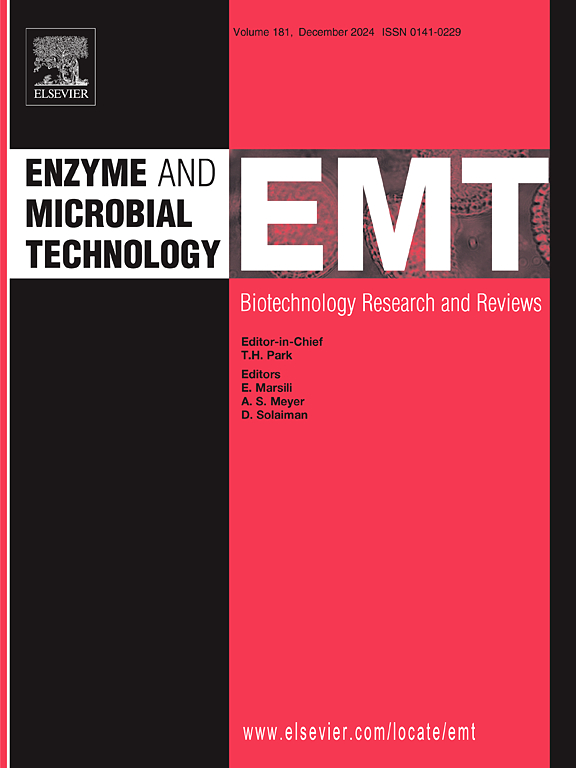一种新型约氏红球菌(Rhodococcus jostii) RHA1脱氟酶的鉴定和重组表达,用于PFAS化合物6:2氟端粒羧酸的脱氟和生物转化
IF 3.7
3区 生物学
Q2 BIOTECHNOLOGY & APPLIED MICROBIOLOGY
引用次数: 0
摘要
聚氟和全氟物质(PFAS)是令人关注的新兴污染物,被认为与造成许多不利健康影响有关,例如免疫抑制、癌症发展机会增加以及人类肝酶水平改变。然而,考虑到C-F键的键解离能高达544 kJ/mol, PFAS被认为具有高度持久性和抗生物降解性。虽然许多研究报告了细菌分离物和微生物群落对PFAS的生物除氟作用,但对生物除氟的分子基础知之甚少。本研究发现了一种新的脱氟酶,该酶利用转座体插入诱变和异源表达相结合的方法,对rj .jostii RHA1中6:2氟端粒羧酸(6:2 FTCA)进行生物脱氟。从417的图书馆 R。jostii RHA1。当暴露于6:2的FTCA时,3个个体突变体失去了去氟化的能力(突变体# 15、32和38 -表S2)。所有3个非除氟突变体的遗传位点被发现编码一个假定的MhPC超家族蛋白。已知MhPC超家族蛋白含有其他蛋白,如氟乙酸脱卤酶(UniProt - Q6NAM1),这些蛋白能够切割- c - f键。该基因被克隆到异源表达宿主MC2-155中。诱导后,M. smegmatis MC2-155转化能够以13 µmol/h的速率(在Michaelis-Menten模型中,Vmax = 80.9µmol/min, Km = 5.04 mM)对6:2的FTCA进行除氟。相比之下,在非生物或生物对照中均未观察到除氟现象。对该新型脱氟酶的进一步表征表明,该酶能适度脱氟不饱和PFAS化合物6:2 FTCUA(4.9 µmol/h氟)和5:2 sFTOH(1.3 µmol/h氟)。新型去氟酶对其主要PFAS底物6:2 FTCA的最大比活性为12.9 ± 1.9µmol F/hr/g蛋白。然而,它对5:3 FTCA或磺化PFAS化合物(如6:2 FTS和8:2 FTS)没有活性。野生型红球菌能以2.2 µmol/h的速率去氟6:2 FTCA。该MhPC类新型脱氟酶在WT R.jostii RHA1中的发现。具有巨大的价值,因为它负责启动PFAS化合物去氟化的关键步骤,如6:2 FTCA。本文章由计算机程序翻译,如有差异,请以英文原文为准。
Identification and recombinant expression of a novel defluorinase from Rhodococcus jostii RHA1, for defluorination and biotransformation of the PFAS compound 6:2 fluorotelomer carboxylic acid
Poly and per fluorinated substances (PFAS) are emerging contaminants of concern that are thought to be involved in causing numerous adverse health effects, such as immunosuppression, increased chance of cancer development, and altered levels of hepatic enzyme levels in humans. However, PFAS are considered highly persistent and resistant to biodegradation given the fact that the C-F bond can have a bond dissociation energy of up to 544 kJ/mol. Though many studies have reported PFAS biodefluorination by bacterial isolates and microbial communities, little is known regarding the molecular foundations for biodefluorination. In this study, a novel defluorinase was identified, that is responsible for the biodefluorination of 6:2 fluorotelomer carboxylic acid (6:2 FTCA) in R.jostii RHA1 using the combination of transposome-based insertional mutagenesis and heterologous expression. From a library of 417 R.jostii RHA1. mutants, 3 individual mutants lost their ability for defluorination when they were exposed to 6:2 FTCA (mutant # 15, 32 and 38 – Table S2). The disruption of the genetic locus in all 3 non-defluorinating mutants was identified coding for a putative MhPC superfamily protein. The MhPC superfamily of proteins is known to harbor other proteins such as fluoroacetate dehalogenase (UniProt - Q6NAM1) that are capable of –C-F bond cleavage. This identified gene was cloned into the heterologous expression host M. smegmatis MC2-155. After induction, the M. smegmatis MC2-155 transformant exhibited the ability to defluorinate 6:2 FTCA at a rate of 13 µmol/h (Vmax = 80.9 µmol/min and Km = 5.04 mM in Michaelis-Menten models). In contrast, defluorination was not observed in either abiotic or biotic controls. Further characterization of the novel defluorinase indicated that it could moderately defluorinate the unsaturated PFAS compound 6:2 FTCUA (4.9 µmol/h fluoride) and minimally defluorinate 5:2 sFTOH (1.3 µmol/h fluoride). The novel defluorinase indicated a maximal specific activity of 12.9 ± 1.9 µmol F/hr/g protein, against its primary PFAS substrate, 6:2 FTCA. However, it showed no activity with 5:3 FTCA or sulfonated PFAS compounds such as 6:2 FTS and 8:2 FTS. The wild-type Rhodococcus could defluorinate 6:2 FTCA at a rate of 2.2 µmol/h. The discovery of this MhPC class novel defluorinase in WT R.jostii RHA1. has substantial value since it is responsible for the critical step that initiates defluorination of PFAS compounds such as 6:2 FTCA.
求助全文
通过发布文献求助,成功后即可免费获取论文全文。
去求助
来源期刊

Enzyme and Microbial Technology
生物-生物工程与应用微生物
CiteScore
7.60
自引率
5.90%
发文量
142
审稿时长
38 days
期刊介绍:
Enzyme and Microbial Technology is an international, peer-reviewed journal publishing original research and reviews, of biotechnological significance and novelty, on basic and applied aspects of the science and technology of processes involving the use of enzymes, micro-organisms, animal cells and plant cells.
We especially encourage submissions on:
Biocatalysis and the use of Directed Evolution in Synthetic Biology and Biotechnology
Biotechnological Production of New Bioactive Molecules, Biomaterials, Biopharmaceuticals, and Biofuels
New Imaging Techniques and Biosensors, especially as applicable to Healthcare and Systems Biology
New Biotechnological Approaches in Genomics, Proteomics and Metabolomics
Metabolic Engineering, Biomolecular Engineering and Nanobiotechnology
Manuscripts which report isolation, purification, immobilization or utilization of organisms or enzymes which are already well-described in the literature are not suitable for publication in EMT, unless their primary purpose is to report significant new findings or approaches which are of broad biotechnological importance. Similarly, manuscripts which report optimization studies on well-established processes are inappropriate. EMT does not accept papers dealing with mathematical modeling unless they report significant, new experimental data.
 求助内容:
求助内容: 应助结果提醒方式:
应助结果提醒方式:


